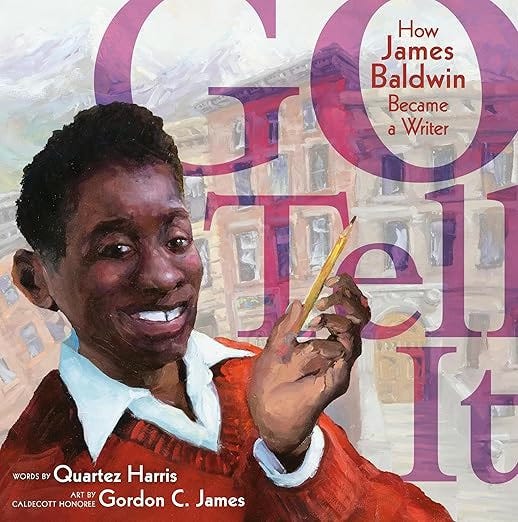“The first time James Baldwin read a book, the words clung to him like glitter.”
Thus begins Quartez Harris’s book Go Tell It: How James Baldwin Became a Writer. In lyrical prose, Harris places young James in his Harlem home where he helped his hardworking mother care for his siblings, felt her encouragement to love books and reading, and heard his stepfather’s fiery sermons about the only book he wanted James to read: the Bible.
James found solace in the public library: “The more he read other people’s words and heard the music in them, the more he wanted to make his own sound.” In his mind’s eye, the streets of Harlem exploded with words—exciting words, joyful words.
Yet there were also hateful words, leading him to understand better the anger behind his stepfather’s exhortations. With the encouragement of his mother and a teacher at school, Jimmy absorbed the artistic environment around him and, of course, welcomed the glitter of new books. At fourteen, he countered his stepfather’s angry sermons with his own sermons of joy and hope, setting him apart from his stepfather.
Though often teased by classmates, he made new friends in school (friends of whom his stepfather did not approve), and after graduating earned money enough to travel to Paris where he wrote and wrote. Words about his Harlem childhood tumbled forth. In his first novel Go Tell It on the Mountain, “the world saw itself glittering through Jimmy’s eyes.”
Vibrant, painterly illustrations by Gordon C. James grace the pages of this descriptive picture book biography. “More About James Baldwin” closes the narrative with additional details of Baldwin’s life and writing; notes from both the author and illustrator confirm the passion each brought to their portrayals of one of America’s iconic writers.
Ages 5-9. Little, Brown Books for Young Readers, 2025.
The National Museum of African American History & Culture has a biographical essay about James Baldwin.
A Reading Guide to The Fire Next Time is provided by the book’s publisher, posing important questions about the relationship of Baldwin’s work to today’s world.
.





